Good open source software to help design municipal WW treatment plants? Why so many over designs?
Published on by Paul Jacob, Asian Institute of Technology (AIT) - Research Associate in Technology
A few months ago I was approached to help design a wastewater treatment plant for municipal wastewater (a draft version for a proposal for activated sludge system). I was not confident about the models I was using for detailed design and calculations and thought that to develop our own would be like reinventing the wheel. So I searched online for some software that could help me to check the results and give confidence not to over or under-design the system.
I found some software but I am not sure if the people in the industry are using the same. As per my research I found the software below, all of them are paid versions.
2. Audesk (water and wastewater )
3. Various softwares by http://www.hydromantis.com/products.html
Can someone point me towards an open source software that I might be able to use ?
Additionally, I would like to know experts candid view on an observation.
While considering the municipal wastewater treatment plant design for SBR or AS, we assume a value of around BOD 150-250 mg/L and 250-500 mg/L at the influent. I saw many WWTP in Thailand are designed based around these values. But in reality one of my friends (operator for municipal wastewater treatment) and I have personally seen that the influent is generally not over 30-60 mg/L BOD and a COD 45-100 mg/L but had a lot of SS. I suspect this is due to storm water is being mixed with wastewater.
So my second question is: Is it overkill to design a wastewater treatment plant with high influent BOD and COD ? While the actual situation barely meets the criteria to keep the MLSS alive ? Then why do so many consultants design wastewater treatment plants with such influent values? Maybe a safety factor but so much energy and capital is lost due to this safety factor. Any opinions or personal experience or case studies or standard methodology regarding this matter would be really nice.
Taxonomy
- Water
- Treatment
- Sewage Treatment
- Industrial Wastewater Treatment
- Modelling
- Waste Water Treatments
- Modeling
- Wastewater Treatment
- Wastewater Collection
- Environment
- Wastewater Treatment Plant Design
- Water & Wastewater
- Water & Wastewater Treatment
- Water
- Water
- Water & Wastewater
- Water Software
19 Answers
-
The Water Network research team has consolidated an updated answer to the above question.
Further input from members is welcome and appreciated.
A free WWTP design generator tool hosted on The Water Network is our suggestion for designing a wastewater treatment plant.
 All you need to do is fill in the parameters and wait a few hours to get the complete design in your email.
All you need to do is fill in the parameters and wait a few hours to get the complete design in your email. The tool generates the best Wastewater Treatment Solution based on the information about the geographical region, COD, BOD, TSS, nutrients, water quality characteristics, population and flow parameters, etc.
You can request an advanced design with the details stated above or a basic design which requires less information.
Generate your own Wastewater Treatment Plant Design - here.
-
I`d like to help you, but I don`t know any of it. But I now some useful open source apps for Android and iOS, maybe you will need them to solve your other questions.
-
According to Paul Jacob who posted this article 2 years ago, the real issue of the poor design was the WRONG data. In his case, the sewage was diluted 5 - 10 times with rain or surface water. Unfortunately his case is quite typical for many STP (sewage treatment plants) designs. Even when using the best textbooks and software tools STP designs will fail when one feeds it with wrong data: garbage in = garbage out.
-
The Water Network research team has consolidated an answer to the above question.
Further input from members is welcome and appreciated.Free open-source software which can be used for designing a wastewater treatment plant:
- BioWin
- SWMM
- OpenModelica
- STOAT
- ASIM
- Steady *
1.BioWin
BioWin is used to design, upgrade and optimize wastewater treatment plants (WWTP). BioWin is a wastewater treatment process simulator with focus on the biological, chemical and physical process.
BioWin is very easy to use and customizable. Additionally, pre-configured flowsheets and available.
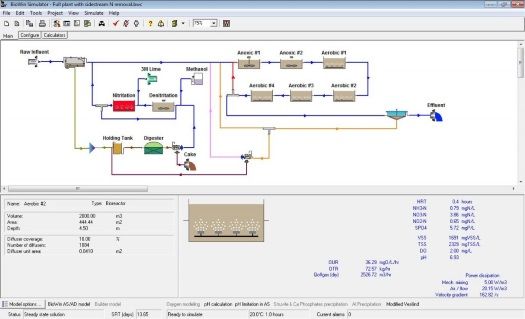
2.Storm Water Management Model (SWMM)
SWMM is used for drainage systems mostly in urban areas, but has applications in non-urban areas too.
It is used for planning, analysis and design of stormwater runoff and sanitary sewers.
SWMM is a dynamic hydrology-hydraulic water quality simulation model.
It is used both for events and continuous simulations of runoff quality and quantity in all the subcathchments. It tracks the flow rate, flow depth, and quality of water in each pipe and channel.
SWMM 5 includes low impact development (LID) controls is the model:
- Permeable pavement
- Rain gardens
- Green roofs
- Street planters
- Rain barrels
- Infiltration trenches
- Vegetative swales
It therefore ensures a precise picture of influence of combinations of LID controls in managing stormwater and combined sewer overflows.
SWMM can approximate the pollutant loads in stormwater runoff.
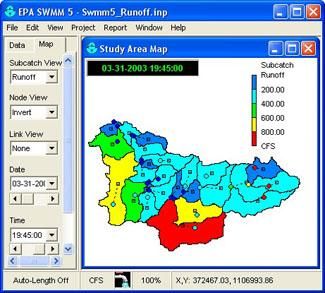
* Some examples of documents which used SWMM:
Storm Water Management Model Reference Manual
Storm Water Management Model, Quality Assurance Report: Dynamic Wave Flow Routing3.OpenModelica
OpenModelica is free and open-source modeling and simulation environment.
It is based on the modelica modeling language.
OpenModelica is used for dynamic simulation and optimization.
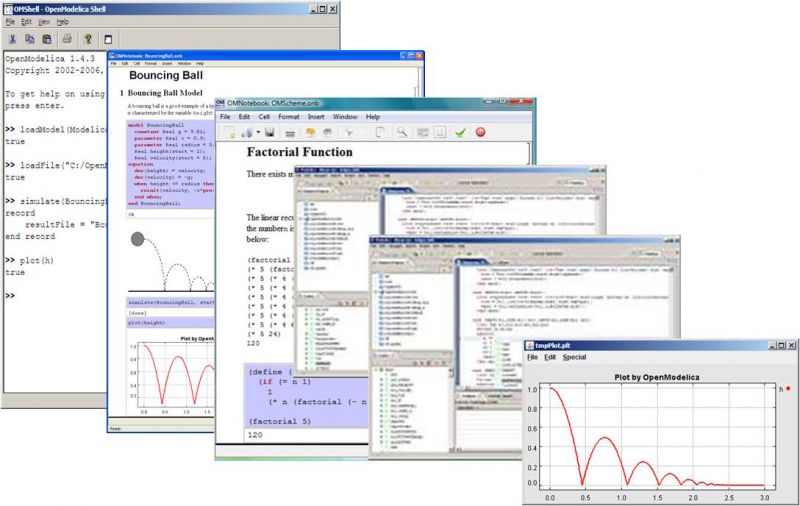
4.STOAT
STOAT is used for dynamic modeling of wastewater treatment plants.
It is a dynamic sewage treatment works modelling package.
STOAT can be used for activated sludge systems, biofilm-based processes and sludge treatment modeling.

5.Activated Sludge SIMulation Program (ASIM)
ASIM is a simulation program for biological wastewater treatment systems.
It can make models for activated sludge (aerobic, anoxic, anaerobic), sludge return and internal recirculation streams, batch reactors, chemostat reactors…
ASIM differentiates process control loops and dynamic simulation of load variation.
A great ASIM option is a free definition of biokinetic models, enabling specific models to be built.
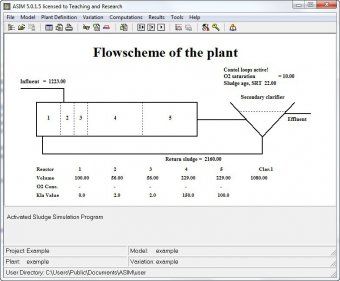
6.Steady
Steady is not open source, but is a free program.
It offers a generalized model of wastewater treatment plants with steady-state conditions for influent, with traditional environmental engineering parameters.
Parameters for each unit can be adjusted so it calculates the mass balance and shows calculations for each unit.
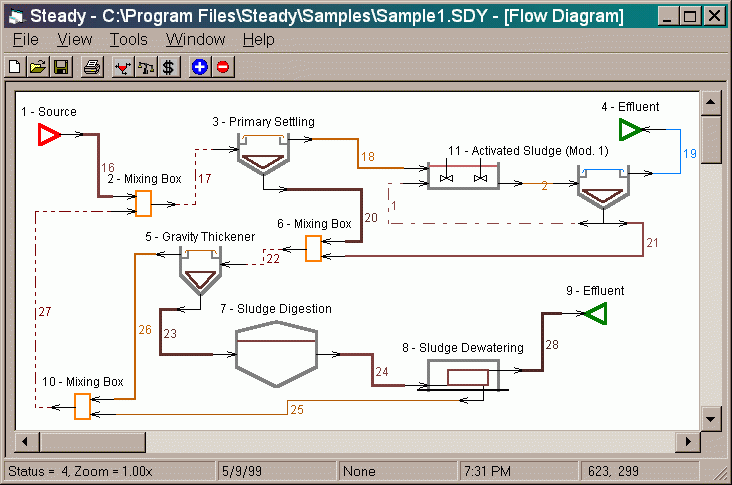
Regarding your question about biochemical oxygen demand (BOD):
It is better to assume higher values of BOD than underestimate them. Moreover, when making a wastewater treatment plant you should take into consideration that with time and population growth, the influent may increase. If higher influent is not predicted in time, the plant will require modifications or an additional one may need to be built.
Additionally, when measuring the BOD values you need to make sure you are measuring them at the time of the day (morning and lunch time) when the water consumption in the city is the highest and therefore they are at their peak.
Hourly measurements are recommended for an accurate status of the BOD peak and the calculations of how the BOD range varies during the day. -
Good people, When i was going through different technological ideas i thought this network is very rich in coming with great work on the ground. I totally recommend great thinking and capabilities that our team have. In low development countries such as Malawi where wastes management is an issue such technological investments are of great important. Therefore, i am crying in my heart on how all knowledge and hard thinking individuals would come together and have a strong network that would even help design technologies acting as a solution to local person and government at large.
-
Software
You can download STOAT.
-
Hello Paul, I think the reason for the "overkill" falls into two main areas: 1. Risk abatement - Consultants want to ensure they build a solution that works. At the same time they often "over-spec" a solution because they feel the requirement will probably increase over time as population and local industry pressures build up. They argue it is better to build an "over-spec" plant rather than having to build a new one in 5 to 10 years because the inputs have increased. This is a sound argument from a risk management point of view. 2. Vested interest related to the consulting brief - The other significant driver is a more difficult issue. Often wastewater consultants have either a direct or indirect association with engineering firms that build WTP's. These engineers influence consultants, overtly or not, to argue for "over spec" solutions. The engineers then build a solution that generates more revenue and profit for the engineering firm. This is not to say that this quasi-corrupt conduct is happening all the time. It isn't. But it’s potentially a risk in the consulting and capital deployment phase of the WTP project. It is also worth considering that these "over specking" influences by engineers on consultants can be subtle and build up over a long period. For instance, even if the consultant has no direct financial relationship with an engineering group: Ø he or she could have been a water engineer in the past (and maybe worked with the engineers) Ø could have been friends with the engineers for several years (working in an industry where people have lots of common contacts) Ø wants to ensure that the engineers have a successful business. So, the answer to your question is more related to human nature in business rather than a specific technical one.
-
Open source software for WWTP design
Hi Paul,
I am not aware of any open source comprehensive software for WWTP design. But if you visit the website www.worldenviro.com, you may find the details of software which can be used to design effluent/sewage treatment plant using variety of processes particularly the sizing. But SBR is not included. The software is not free. But it is not costly.
-
"While considering the municipal wastewater treatment plant design for SBR or AS, we assume a value of around BOD 150-250 mg/L and 250-500 mg/L at the influent. I saw many WWTP in Thailand are designed based around these values. But in reality one of my friends (operator for municipal wastewater treatment) and I have personally seen that the influent is generally not over 30-60 mg/L BOD and a COD 45-100 mg/L but had a lot of SS. I suspect this is due to storm water is being mixed with wastewater. So my second question is: Is it overkill to design a wastewater treatment plant with high influent BOD and COD ? While the actual situation barely meets the criteria to keep the MLSS alive ? Then why do so many consultants design wastewater treatment plants with such influent values? Maybe a safety factor but so much energy and capital is lost due to this safety factor. Any opinions or personal experience or case studies or standard methodology regarding this matter would be really nice." You may have low BOD/COD. Many sewage works are designed to discharge an effluent that shall not exceed 30 mg/l BOD, 125 mg/l COD. You may also have taken your samples at an inappropriate time. There is a diurnal pattern to sewage flow and concentration. Typically the peak flow/load entering the sewage works is around 7 – 9 am – may be different for your location – linked in with the morning rush. How long this takes to reach the sewage works then depends upon the design and layout of the sewers. There is a second peak, for the evening. If you are mostly industrial, with people living away from the area, your peak may be around lunch but with a larger baseline from the industrial contribution. So – if you sampled (say) 11 am you may have taken a minimum concentration rather than a maximum; and either way you really need to consider taking hourly samples for (say) Mon, Weds, Fri to pick up the weekday pattern, and Sat/Sun for the weekend. If you have ‘a lot of SS’ with low BOD/COD you may be looking at some industrial component discharging a lot of inert solids. It is worth doing a volatile solids test. If the volatile solids is around 75% - say, 65 – 80% - then most of your waste is probably of domestic origin. Lower than 65% and a lot of grit is entering the system from somewhere. Higher than 80% and you may have someone disposing a lot of degradable waste – brewery? The values that you see quoted as the common values are those that are usually found with domestic sewage and a moderate level of industrial contribution, and look more like US than European values. The values are affected by how much people eat, how much water they use, how much infiltration takes place, how much the sewers are double up a storm sewers. There has been much analysis from the Thai universities, but usually in Thai, so I cannot comment on what the theses contain.
-
My take on it
There is one open source program for wasteawter treatment. This is to use OpenModelica with the Modelica Wasteater Treatment Library. This gives you conventional activated sludge systems, but not SBRs.
If you look hard you may find an old copy of SeTS, which runs under Scilab. This also does not have SBRs.
Finally, in SourceForge, there is the uncompleted Killarney project, which would again not have SBRs. Killarney was being developed in C++.
If you want non-opensource, but free, then look at WRc STOAT. I help develop this, so naturally am rather biased. It does have SBRs.
Then, as you wrote, are the commercial programs: Hydromants' GPS-X, Envirosim's Biowin, Ifak's SIMBA, DHI's WEST and (coming soon) Dynamita's SUMO. For your needs - SBR and activated sludge - all are equivalent, and your choice, if you go down that route, would be based on criteria other than are they appropriate for your immediate problem.
-
Hi Paul Yes SWMM is to design a wastewater network and EPANET to a drinking water distribution network. Both by EPA Environmental Protection Agency (www.epa.gov) *About the water quality there are other Opens by EPA (see: http://www.epa.gov/athens/wwqtsc/html/water_quality_models.html), but on regard the pollutants in a water body, if you will need a day. I am glad that I have given an input. Regards, Giampietro Martini
-
@ Tsuzuki San, Thank you. As I looked into the paper. I noticed that you worked with Dr. Thammarat. I am a past advisee. Thanks again for sharing the paper.
-
Dear colleague, for my experience in sobrediseños, and reinstalling improvement treatment plants, there are some key factors that could comprovar many years ago, my surprise was that each month had to repair water pumps, being one of the German and best brands in the world, I discovered that all the pipes were iron pools with vibration seals were broken and then the coil broke, had no fastenings and flexible rubber or rubber platform, the last part of the process was chlorination and return the treated water to the river resulting death of vegetation and fauna of the river, another serious problem is lack coordination related to companies and their discharges, a very simple example, blood from a slaughterhouse animals, day of mass slaughter, whole plant descontrolava directly affect active microorganisms that purify the water, operating sofwar was a synoptic, and a reader aguia quality input and output, and a maintenance program in an annual book but the plant was the most modern in the world, "biological" have come a long way since then and my advice is to collect information with a good team of experts and design and make your own sofwar, in our company we design the process and the sofwar, and I can assegurar the cost is enormous, the day that will put him amortize investment in open source, now do the opposite, we encrypt the sofwar and manipulated so that it can be copied or purchased, unfortunately there are many companies waiting for you to do the effort and then they benefit and profit from all your development and sink try if you can, if you get in touch with me can help in certain things, altruistically, but as a person not as a company, I tired of working for free and for some to take advantage of our innovations and developments without putting even a dollar, I think that's why you will not find a set of open source and also there is a standard in my opinion for water treatment that is a error every country, city industry has specific features and you have to be able to adapt to them, always designs over what you require and above are consistent with your own conclusions, improving the existing process, because there are many things to improve .
-
It is obvious by now that centralized waste treatment facilities using chlorine are outdated and the maintenance on the infrastructure is impossible at todays prices. The bioremediation technology is sufficient to stop all construction on any new centralized plants and focus on decentralized home and or business reprocessing units. No infrastructure to build or maintain. No odor or pathogens being transported many miles hoping for no break in the system. Additionally the bio cleaned bio solids can be used at home or business as compost for lawns and gardens retaining moisture and eliminating the need for chemical fertilizers and pesticides. Another side benefit is the Bio digester units make electricity as a byproduct. The software required for these new systems would be simple and affordable. Free energy, free fertilizer, healthy food, reduced water consumption. The new system pays for itself in the first year.
-
Hi Paul, We are lucky having very good discussions on the topic you just posted. Great discussion started when you clearly stated a situation and your desired results. When you can draft again your initial data with the ideas pouring in , kindly share again to the group with the estimated amount of the influent with its BOD/COD analysis. Let our group again know your desired results..BOD,COD,MLSS, pH, etc.. Perhaps we can suggest a more efficient design. Regards, Edwin
-
Hi Paul, This is the link to download the Open Source SWMM: http://www.epa.gov/athens/wwqtsc/html/swmm.html Below you will find my entire comment. Regards, Giampietro Martini
-
Hi Paul, In order to design an urban drainage network you can use the open source: SWMM. I think the greatest difficulty is to know the amount of pollution that the runoff can yield and the data are not always easy to find. About this software you can check the rate of pollution in each node. If the network is already present you can make a model it with that reproduces it and calibrate the parameters. Since you have got a satisfactory solution of the discharge, the wastewater are under the laws of the Country. You must build a spillway when the concentration of the black flow exceeds a certain value (the dilution ratio depends on the setting region) the discharge goes to water treatment, other goes to a water course. Once you know what you have to treat you can go to a specialising company. For the second question. The amount of BOD or COD depends on the laws of the State and to the number of inhabitants in to the basin drainage. For example in my country (Italy) for urban agglomerations > 100,000 inhabitants there is the lower limits of 125 [mg / l O2] for COD and 25 [mg / l O2] for BOD. So I think you have to see the legislation and the number of inhabitants of the municipality. But to create a network of the urban drainage SWMM is reliable and not difficult to use, and it all comes down to the reliability of the data. You can do various simulations and to change the scenario and you should always checking the results with other similar basins . The oxygen present in the fluid is the carrier for microorganisms which decompose organic substances, so I would say that a high value is in favor of security. I am a hydraulic engineer, and I do not know the specifications to built to a treatment plant, I know the necessary components to its management. But according my knowledges there are not a open source software to design a treatment water plant. This is the link to download the Open Source SWMM: http://www.epa.gov/athens/wwqtsc/html/swmm.html I hope I have been helpful, a little bit. Regars, Giampietro Martini
-
Hello Paul. The Advantage of the Biological Cleansing it is that it removes the management software, the infrastructure of connection and of collection of domestic sweated water and especially the Biological cleansing does not transform the fecal matter into mud. 2000 millions de tonnes en France. No software no infrastructure even disproportionate will be capable rivalsier with the Biological Cleansing. especially in price. for example. a commune of 980 H of France must completely re-examine its information system strategic plan of collective cleansing arrived in limit of collection with a STEP of 1800E/h except service. One is already in right to put the question which a software will be able to never solve: why an installation of treatment not having never suffered since not having received more half of its possible load died, HS. estimated cost of this new information system strategic plan of cleansing with U STEP new: 6 d'€ million. As much money for a quasi worthless performance épuratoire near to zero, since the STEP will change the fecal matter into mud which it will be necessary to direct towards palliative treatments and which the water of rejection will be sent as known as Eric about a natural middle hydraulic with diluted all diffuse pollution that it contains. Lyseconcept presented its information system strategic plan of biological cleansing for financial costs of 600,000 € over 10 years with a performance épuratoire from approximately 98% without obligation of palliative treatment since no production of residues. The municipality borrows just the sum which and necessary for the individual cleansing that the users refund up to al borrowed sum. Then it does not pay anything any more and the refunded money is used for the installation of new establishment. A country as France with the CEBRE can save on the budget cleansing more than 150 billion d'€ in 5 years. If the CEBRE interests you to contact me on my limps transport: lyseconcept@gmail.com for information: all these data of DBO, DCo are completely éronnées since the majority of the effluents of the collective cleansing are soaked with micro pollutant chemical. The latter destroy the total colony count (micro organizations) which do not biodégradent absolutely the fecal amtière and in more if one rejects these waste waters on a discharge system vegetalized this last not having any vocation to purify waste waters will be quickly in chemical saturation. the plant being used only to air the layers of muds which accumulate on the mud tumulus to prevent that this last implodes by methanisation.
-
WW Software Answer
Biowin is a widely used software to design WWTP. Often conservative influent WW quality is used in the absence of good historical data, or if one is designing a WWTP in a new development and the parcel zoning and is still unknown.